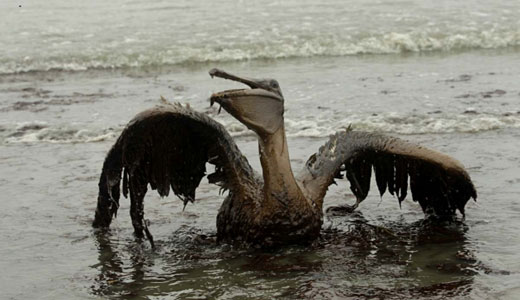
In the wetlands of northern Alberta, Canada, outside the town of Zama City, everything is stained with the thick, pungent blackness of oil. The waters there are filled with nearly three million gallons of a salty oil-water mixture, in what is one of the largest North American spills in recent history.
Trees and other vegetation are dying, and wildlife is in danger. The substance has poisoned tributaries in the area, and threatens to reach the nearby Zama River. Following a seemingly endless slew of environmental tragedies, this latest spill is just one more disaster and one more ecosystem endangered.
The spill was first reported on June 1, but the full extent of the damage was not made public until June 12. It is the result of a leaking produced-water pipeline, which has since been plugged. Produced-water is an oil industry term for water mixed with oil that comes up from the ground when crude is extracted. It is an unstable mixture of hydrocarbons, high salt levels, sulfur compounds, metals, and naturally-occurring radioactive materials, making it a deadly toxic cocktail for the environment. The leak is believed to have begun months ago, but went largely unnoticed until June 1.
The pipeline was operated by Houston, Texas-based Apache Corp., whose spokesman Paul Wyke insists that the “salty water” only contains “trace amounts of oil,” and that the company has “seen no impacts” on wildlife. So far, “the Zama River has not been impacted,” he added, “and there is no risk to the public.” Apache is reportedly working with the Energy Resources Conservation Board to determine what caused the leak.
For the Dene Tha’ First Nation, which governs tribal communities that live near the area, the attempt by the corporation to downplay the extent of the damage is in vain. Dene Tha’ chief James Ahnassay said, “Every plant and tree has died in the area touched by the spill.” He believes that waterfowl have already died from the toxicity, and that more animals are in danger. He suspects that the pipeline leak is just one more example of a lack of government oversight in the oil industry. “We don’t believe that the government is doing enough to ensure upgrades and maintenance of the pipelines.”
Greenpeace Canada said that the affected area is a vital habitat for birds and other wildlife. Group spokesman Keith Stewart said the oily wastewater’s compounds are a major hazard to those animals. “This is a massive spill of toxins into one of the most important wetlands in Canada, if not the world.” “The government shouldn’t be trying to hide these things,” he said, blasting officials for not releasing exact details of the spill until June 12. Greenpeace further noted that Apache has not yet allowed actual photos of the spill to be released.
In recent years, it seems, major oil disasters are increasingly occurring within months of each other. The Alberta incident follows another major event, the March, 2013 Mayflower, Arkansas oil spill in the U.S., which occurred when the ExxonMobil-owned Pegasus pipeline leaked. That one caused irreparable damage and directly affected a town full of people, who are still dealing with the aftermath, which has sickened many and will last for years.
And the devastation of the 2010 Deepwater Horizon oil spill in the Gulf of Mexico is still being felt, despite BP’s claims of successful cleanup efforts. In fact, the oil corporation has – prematurely – finished wrapping up those efforts in three of the four affected states. Environmental restoration has barely begun there; it could take decades. But even though “one million barrels of oil from the disaster remain unaccounted for,” according to the National Wildlife Federation’s David White, BP is too busy footing the bill for a new beachfront hotel to be built on state park property near Gulf Shores, Alabama. The company considers the hotel construction part of its promised ‘coastal restoration’ efforts, while infuriated environmentalists feel that money should go toward rebuilding the decimated wetlands.
It’s worth mentioning that conditions in the Gulf haven’t improved since then. Far from it. Instead, another incident occurred near the Gulf in April 2013, when a pipeline malfunction at an ExxonMobil refinery sent oil gushing into the waters near Chalmette, Louisiana.
Pipelines, by the way, are more likely to cause oil spills than shipments of crude by rail, according to a study by the International Energy Agency, using U.S. Department of Transportation data. The study found that pipelines in the U.S. gushed three times more oil than trains for comparative distances over an eight-year period.
Back in Canada, the provincial government of Alberta would point out that the number of pipeline-related spills there has been dropping steadily since 2011, but their database is reportedly missing data in several places, and does not record certain spills that cross national borders. And anything under about 528 gallons doesn’t get counted. Another important fact is that most of Alberta’s pipelines are 40 to 50 years old, and thus in drastic need of an update.
The issues in Canada also illustrate the dangers of pipeline oil transportation in America. Sierra Club executive director Michael Brune remarked, “Oil companies cannot be trusted to transport toxic crude through America’s backyards, farmland, and watersheds.”
With the ever-looming threat of the Keystone XL pipeline project, which would bring oil in directly from Alberta, the immense environmental dangers that oil companies pose must be addressed.
Photo: A bird in the Gulf suffers from BP’s Deepwater Horizon oil spill. As with that disaster, the Alberta, Canada spill is believed to have affected water fowl. (Charlie Riedel/AP)










